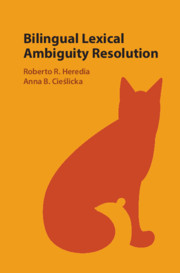Book contents
- Bilingual Lexical Ambiguity Resolution
- Bilingual Lexical Ambiguity Resolution
- Copyright page
- Dedication
- Contents
- Figures
- Tables
- Contributors
- Preface
- Acknowledgments
- Part I Theoretical and Methodological Considerations
- Part II Bilingual Lexical Processing
- Part III Bilingual Sentence Processing
- 7 Bilingual Lexical Access and Reading
- 8 Online Ambiguity Resolution in Bilingual Lexical Access
- Part IV Neuroscience of Bilingual Lexical Access
- Author Index
- Subject Index
- References
7 - Bilingual Lexical Access and Reading
from Part III - Bilingual Sentence Processing
Published online by Cambridge University Press: 24 December 2019
- Bilingual Lexical Ambiguity Resolution
- Bilingual Lexical Ambiguity Resolution
- Copyright page
- Dedication
- Contents
- Figures
- Tables
- Contributors
- Preface
- Acknowledgments
- Part I Theoretical and Methodological Considerations
- Part II Bilingual Lexical Processing
- Part III Bilingual Sentence Processing
- 7 Bilingual Lexical Access and Reading
- 8 Online Ambiguity Resolution in Bilingual Lexical Access
- Part IV Neuroscience of Bilingual Lexical Access
- Author Index
- Subject Index
- References
Summary
This chapter provides an overview of research conducted over the past few decades on bilingual lexical access during reading using eye movement measures. We first present a summary of earlier work on bilingual single-word processing and outline the predictions of the bilingual interactive activation plus model (BIA+; Dijkstra & Van Heuven, 2002) regarding bilingual lexical access during reading. We then review the studies focusing on lexical access during L2 processing and then during L1 processing, while distinguishing systematically early and late stages of processing. Overall, the findings demonstrate that bilingual lexical access during reading is nonselective, as predicted by the BIA+, and that cross-language activation may occur more strongly during L2 than during L1 reading. Several other factors, such as semantic constraint and L2 proficiency, are also identified that modulate cross-language activation and the unfolding of lexical access.
- Type
- Chapter
- Information
- Bilingual Lexical Ambiguity Resolution , pp. 159 - 183Publisher: Cambridge University PressPrint publication year: 2020
References
Further Reading
References
- 9
- Cited by

